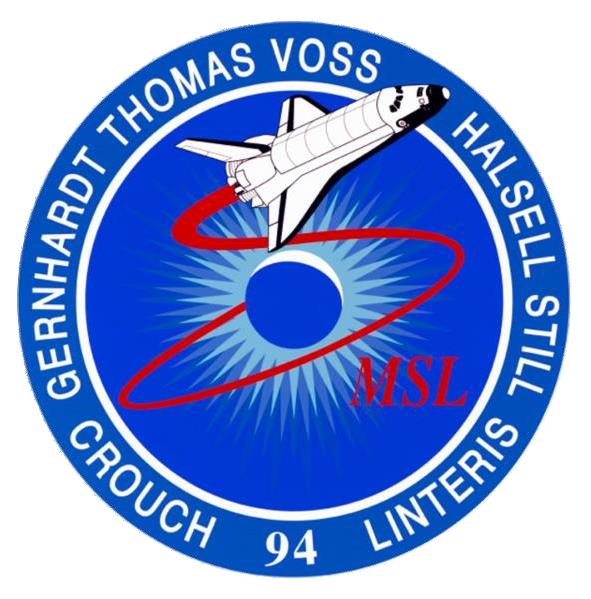Michael L. Gernhardt
Spacelab 030 - STS-94
Mission Name: MSL-R
Astronauts:
Command Pilot:
James D. Halsell
(Third Space Flight)
Pilot:
Susan L. Still
(First Space Flight) Mission Specialist 1:
Janice E. Voss
(Third Space Flight) Mission Specialist 2:
(Second Space Flight)
Mission Specialist 3:
Donald A. Thomas
(Third Space Flight) Mission Specialist 4:
Roger Crouch
(First Space Flight) Mission Specialist 5:
Greg Linteris
(First Space Flight)
Spacelab was a reusable laboratory used on certain spaceflights flown by the Space Shuttle. The laboratory comprised multiple components, including a pressurized module, an unpressurized carrier and other related hardware housed in the Shuttle's cargo bay. The components were arranged in various configurations to meet the needs of each spaceflight.
Spacelab components flew on 22 Shuttle missions between November 1983 and April 1998. Spacelab allowed scientists to perform experiments in microgravity in Earth orbit.
STS-94 marked the first reflight of same vehicle, crew and payloads, following shortened STS-83 mission in April due to indications of a fuel cell problem. Primary payload was the Microgravity Science Laboratory-1 (MSL-1). A quick turnaround in processing Columbia for the reflight was accomplished in part by the first reservicing of a primary payload, MSL-1, in the orbiter.
The crew maintained 24-hour/two-shift operations. Using the Spacelab module as a test-bed, MSL-1 tested some of the hardware, facilities and procedures that will be used on the International Space Station. The 33 investigations conducted also yielded new knowledge in the principal scientific fields of combustion, biotechnology and materials processing.
Combustion experiments resulted in the discovery of a new mechanism of flame extinction caused by radiation of soot, the ignition of the weakest flames (as low as one watt, or 1/50 the power of a birthday candle) ever burned in laboratory conditions in space or on Earth, as well as the longest burning flames in space (500 seconds). Although only 144 fires or combustion experiment runs were scheduled, more than 200 were completed. The combustion investigations provided valuable information for improved fire safety on future spacecraft and for development of cleaner, more efficient internal combustion engines.
Experiments processed in the Electromagnetic Containerless Processing Facility (TEMPUS) yielded the first measurements of specific heat and thermal expansion of glass-forming metallic alloys, and the highest temperature (a maximum of 2,000 degrees Centigrade) and largest undercooling (to 340 degrees C) ever achieved in space. These measurements are necessary for modeling industrial materials systems to manufacture new and better products.
The mission also produced progress in learning how to control and position liquid drops which could lead to improvements in chemical manufacturing, petroleum technology and the cosmetics and food industries. Crew performed over 100 test runs - more than double the number planned - in Middeck Glovebox Facility in areas of liquid and bubble behavior, fluids-based heat transfer devices and solid-liquid mixtures. Droplets of a hydrocarbon, heptane, were burned at the lowest atmospheric pressure achieved during a mission.
More than 700 crystals of various proteins were grown during the 16-day mission. Since crystals grow larger and purer in space, this research will help scientists to better understand their structures and to design more effective drugs to treat such diseases as cancer, diabetes and AIDS.
Samples in the Large Isothermal Furnace were processed to study the diffusion of tracers, or impurities, in melted germanium, an element used as a semiconductor and alloying agent. This was the first time diffusion in semiconductors has been studied in space.
The Astro/Plant Generic Bioprocessing Apparatus (AstroPGBA) studied the effect of microgravity on various plants, including a source of an antimalarial drug; another used in chemotherapy treatment of cancer; and a species widely used in the paper and lumber industries.
The Expedite the Processing of Experiments to Space Station (EXPRESS) Rack flew for the first time on MSL-1 (both the STS-83 and STS-94 missions) to demonstrate quick and easy installation of experiment and facility hardware on orbit. It will be used on the International Space Station.
The 25 primary experiments, four glovebox investigations and four accelerometer studies on MSL-1 were contributed by scientists from NASA, the European Space Agency, the German Space Agency and the National Space Development Agency of Japan. A record number of commands - more than 35,000 - were sent from Spacelab Mission Operations Control Center at Marshall Space Flight Center to MSL-1 experiments.

Spacelab Space Missions
Science Research
Study
Research
Main Index
Space Cosmology
*
About
Science Research
Science Theories
Desk
Site Map
BookShelf
Copyright © by Nigel G Wilcox · All Rights reserved · E-Mail: ngwilcox100@gmail.com
Designed by Nigel G Wilcox
Powered By AM3L1A
Pages within this section: Spacelab 01-32
Spacelab C21-30
Sub-Menu
21
M
menu
22
23
24
25
26
27
8
29
30
28
>>>
D
SM










